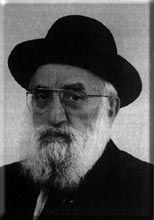Beit Midrash
- Shabbat and Holidays
- The Three Weeks
- The Ninth of Av
The Torah study is dedicatedin honor of
Semon Ben Mazal
2. The Gravity of the Day
3. Wearing Shoes on the Ninth of Av
4. The Exempt from Fasting
Working on the Ninth of Av
The Talmud teaches (Pesachim 54b): "Where it is the custom to do work on the ninth of Av, one may work; where it is the custom not to do work, one may not do work." The law in practice is that where it is the custom to do work on the ninth of Av, one may work. However, whoever does work on the Ninth of Av will not see a sign of blessing from that work.
The Gravity of the Day
Torah authorities differ in opinion regarding the status of the Ninth of Av. Some hold that it originates from Divrei Kabala (sections of the Bible other than the Five Books of Moses); others hold that it originates from Divrei Sofrim (dictates of the sages).
The Rambam (in his Commentary to the Mishnah) explains that Jews continued fasting on the Ninth of Av even during the time of the Second Temple. For this reason, emissaries were sent out to determine the appearance of the New Moon and to inform Jews everywhere regarding the correct date for observing the Ninth of Av. The Tashbetz is perplexed by the words of the Rambam. If the Holy Temple is standing, he asks, why should we mourn its previous destruction?
A likely explanation is that the Rambam holds that because during the Second Temple a number of things that were in the First Temple were missing (The Holy Ark, the Tablets, etc.) people fasted and mourned over the fact that the Second Temple was not like the first in all respects. At any rate, even according to the Rambam, during the Second Temple period, those who wished to fast would fast, and those who preferred not to were not obligated. After all, the Holy Temple was standing.
Wearing Shoes on the Ninth of Av
1. From the Rambam we can infer that a person should not wear shoes with thick rubber soles. Shoes with thin rubber soles are permitted because they allow a person to feel the stones under his feet as he walks. In the words of the Rambam, "It is permissible to go out wearing sandals made of cork or reed. A person may wrap cloth around his feet and go out, for the hardness of the earth reaches his foot and he feels as if he is barefoot " (Hilkhot Shevitat Asor 3:7). Implicit in this ruling is that if the soles of one's shoes are thick, even if they are made from rubber or plastic, they are forbidden.
2. Wooden shoes with leather straps are permitted because the straps only hold the shoes to the feet (see Shulchan Arukh 554:16 and Kaf HaChaim ad loc. 75).
The Talmud (Yoma 69a) says that when Alexander the Great came to Jerusalem in order to destroy the Holy Temple, Shimon the Righteous adorned himself in the clothes of the High Priest and went out to meet him with a large entourage. When they met, Alexander the Great asked Shimon the Righteous, "Why have you come?" "I want to know," said Shimon the Righteous, "how you can allow idolaters to lead you to destroy the house wherein prayers are said for you and your kingdom that it be never destroyed!" Alexander the Great responded, "They are delivered into your hands."
How was it permissible for Shimon the Righteous to wear the clothes of the High Priest outside of the Holy Temple? The Talmud responds by explaining that these were not the real garments of the High Priest. They were, however, fit to be priestly garments. A second explanation brought in the Talmud is that they permitted him to wear these garments, for when "it is a time to work for God, make void His Torah" (Psalms 119:126), i.e., sometime, in order to protect the Torah, the laws of the Torah itself must temporarily be "made void."
The Midrash teaches that Alexander the Great sought to enter the Holy of Holies and Shimon the Righteous told him that only the High Priest enters this place once a year on Yom Kippur. Shimon the Righteous gave Alexander the Great clogs of precious stones and told him, "Put these on and enter." However, because the floor of the Holy Temple was made of marble, Alexander the Great kept slipping. This was Shimon the Righteous' way of hinting to Alexander the Great that it is forbidden to enter the Holy of Holies.
The Exempt from Fasting
A person who is exempt from fasting is only permitted to eat that which is necessary to sustain the body. Any sort of treat or delicacy is forbidden. Once, on the Seventeenth of Tammuz, I saw a respectable Orthodox Jew eating ice cream out in the open, on Jaffa Street. I asked him, "Perhaps you have forgotten that today is a fast day? "I have not forgotten," he replied, "but I am not feeling well, and therefore I am not fasting." I said to him, "It is true that the sages permit the ill to eat, but only according to necessity, and only in private."

"ISRAEL DEFENDS MANKIND"- P' Dvarim- Shabbat Chazon/Tish'a bAv
Rabbi Ari Shvat | Av 5785

All You Need Is Love?
Rabbi Stewart Weiss | Av 5 5781
The People of the Moon
Rabbi Yaakov Asher Sinclair | Tammuz 29 5781























